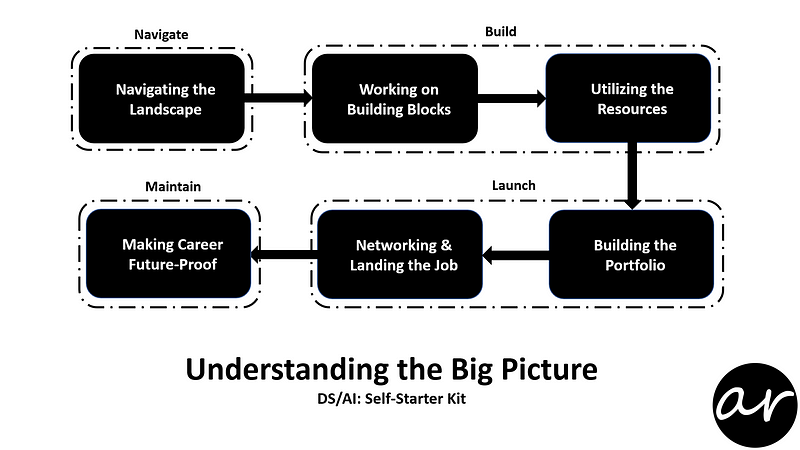Understanding the Big Picture
 on [Unsplash](https://unsplash.com/search/photos/big-picture?utm_source=unsplash&utm_medium=referral&utm_content=creditCopyText)](https://cdn-images-1.medium.com/max/1200/1*PQOXpeZhjL0hNwCz-gzAKw.png)
When you start learning a new skill, the first thing is to look at the big picture and where your would-be skills fit in the field. It gives you a context of what role you can play or are expected to play. And when the skill and field are evolving & overwhelmingly large, you are so engrossed in the details that most probably you tend to miss the purpose.
In my view, to understand the big picture, ask yourself ‘why’ more often and start with the end in your mind.
The following analogy is not particularly about DS/AI but in general.
Job — Interview — Network — Portfolio — Core skills — Resources — Awareness
As you can see above, to land the job you want you to need to crack the interview. To get the call for the interview, you need a network that can refer you for opportunities. To have a relevant & helpful network, you need to have impressive credentials or portfolio. To have a solid portfolio, you need to work on the core skills of the job role that you want. To build core skills, you need to have the right resources. To gather the right resources, you need to have awareness of the field in which you want to build your career.

Now, reverse the order and assess at what stage you are and fill the gap in the coming months to build your career.
Based on the above approach, this post gives you a holistic view of what you need to know and do to build your road-map in DS/AI field.
In upcoming sections, you will get to know about these steps and their details are covered in subsequent posts of the blog-post series.
Each section represents an upcoming blog-post of this series.

Navigating the landscape
Before learning DS/AI, it is very much required that you understand the overall landscape and where all the buzzwords like data science, machine learning, deep learning fit in. In this post, you will learn different terminologies, their meaning and how these are interconnected.
DS/AI is a vast field, not a single person has all the required knowledge or does all day to day tasks. Due to the variety of skills required in data science projects, specific roles are evolving so that individual can contribute according to their abilities. In this post, you will get to know almost all the DS/AI roles, which will give you a better idea which one suits you.
Working on building blocks
This is the core part of DS/AI, knowing the concept, process & tools are the most important part of any job. Intrinsic details of the building blocks are not in the scope of this series. This post will make you aware of what is in the scope of DS/AI field and which role need to have what kind of skills.
After completing this section you will get to know what is in the scope of DS/AI field. You can relate the concepts, process & tools based on the role you think you can fit in. Think of this post as the syllabus of DS/AI field with electives based on your role.
Utilizing the resources
There is no dearth of learning resources but that has only confused the starters in the data science field. I get many questions related to what books to read, what courses to enrol, what blogs/portals to follow, what data-sets to work on.
In this post, I will provide critical reviews of all the prominent books, courses, blogs, portals, data-sets & podcasts etc. Please note that this list is based on my exposure to the field, there may be additional and better resources but I think you will get enough exposure after going through this post to evaluate other resources comparatively.
Building your portfolio
Refining & honing the skills required for a job is one part, showcasing what you can offer is another. What if you have all the required skills but nobody looking for the skill-set is aware that you do. Having a credible portfolio is an effective way to showcase your skill-set and talent.
After going through this post you will get to know what is needed to build an impressive portfolio even before entering the market looking for a relevant job.
Networking & landing the job
You know, you have filtered the best-suited role & honed your skill-set & built the portfolio as well. Your mission is not accomplished unless you have like-minded professionals in your network who are aware of your capabilities and can refer you for the jobs that match your skills. Interview preparation is another task in itself.
This post will focus on the steps required to network & land the job in DS/AI field. How to network with like-minded professionals, how to search for relevant job openings, how to prepare & crack DS/AI interviews.
Putting it all together
Before diving into the details, in the current post, you are looking at the big picture of what will be covered in this series and how that fits into your learning curve as a DS/AI starter/enthusiast.
After going through each step in detail, just like the current post, this post will revisit the high-level steps once again so that we can make sure that you have covered what you needed to.
Appendix
DS/AI is an evolving field due to ongoing technology disruption. While the core concepts remain the same, tools/technology/frameworks will be changing. Any literature published on DS/AI has to be reviewed at regular interval.
Apart from above, there are few additional topics that I would like to cover in this section like Beginners’ FAQs, Data Scientists interviews.
In this section, you will get to know what are the frequently asked questions by DS/AI starters. What current crop of data scientists has done to start their career. How you can continue from here & how to be future-ready in this ever-evolving field.
Ankit Rathi is an AI architect, published author & well-known speaker. His interest lies primarily in building end-to-end AI applications/products following best practices of Data Engineering and Architecture.
Why don’t you connect with Ankit on YouTube, Twitter, LinkedIn or Instagram?
If you have any questions or comments, click the "Go To Discussion" button below!







